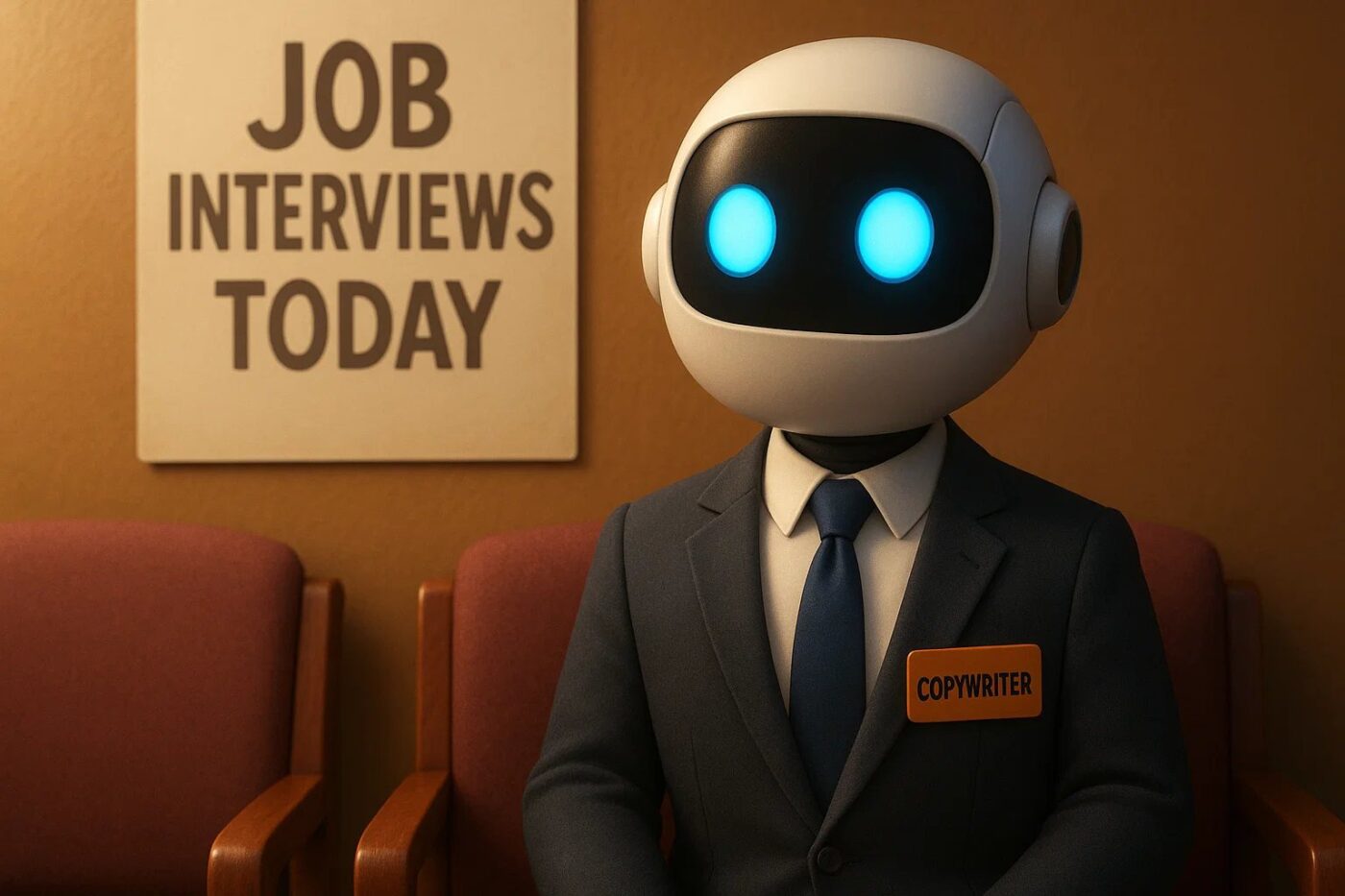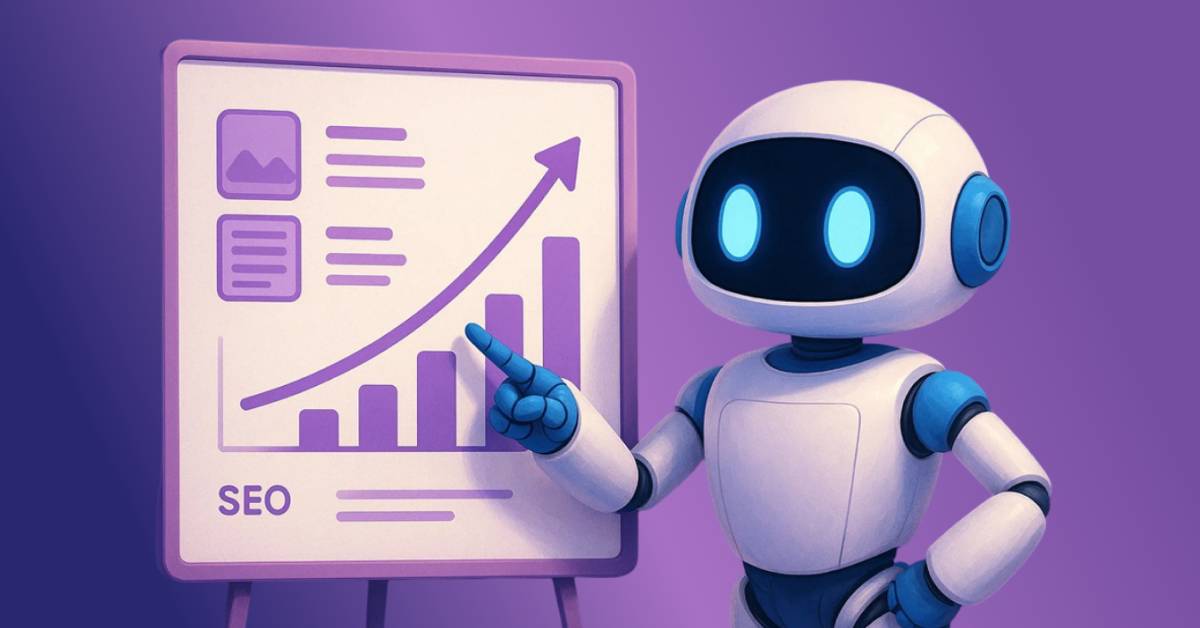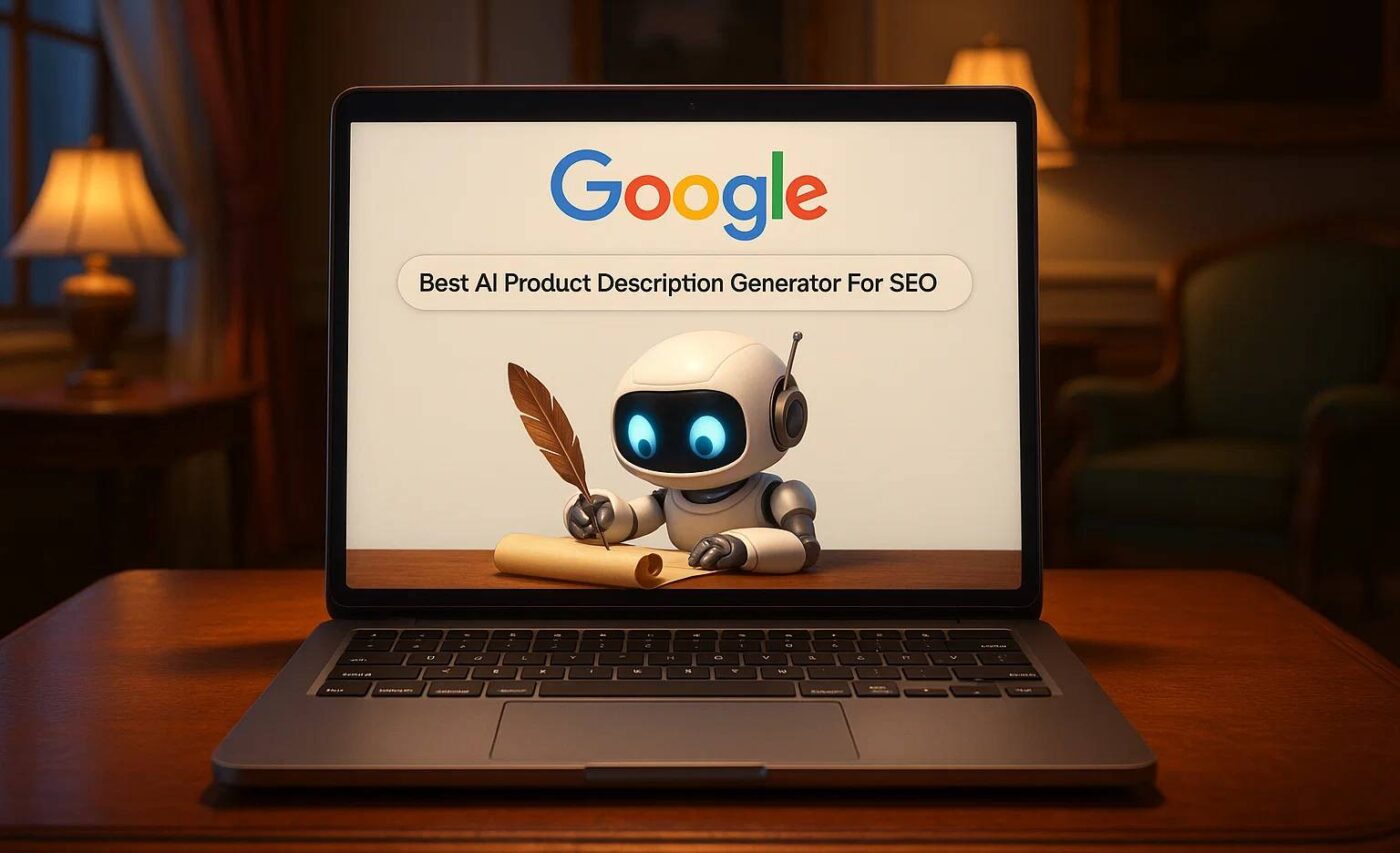What’s the difference between DeepL & ChatGPT? AI Translation?
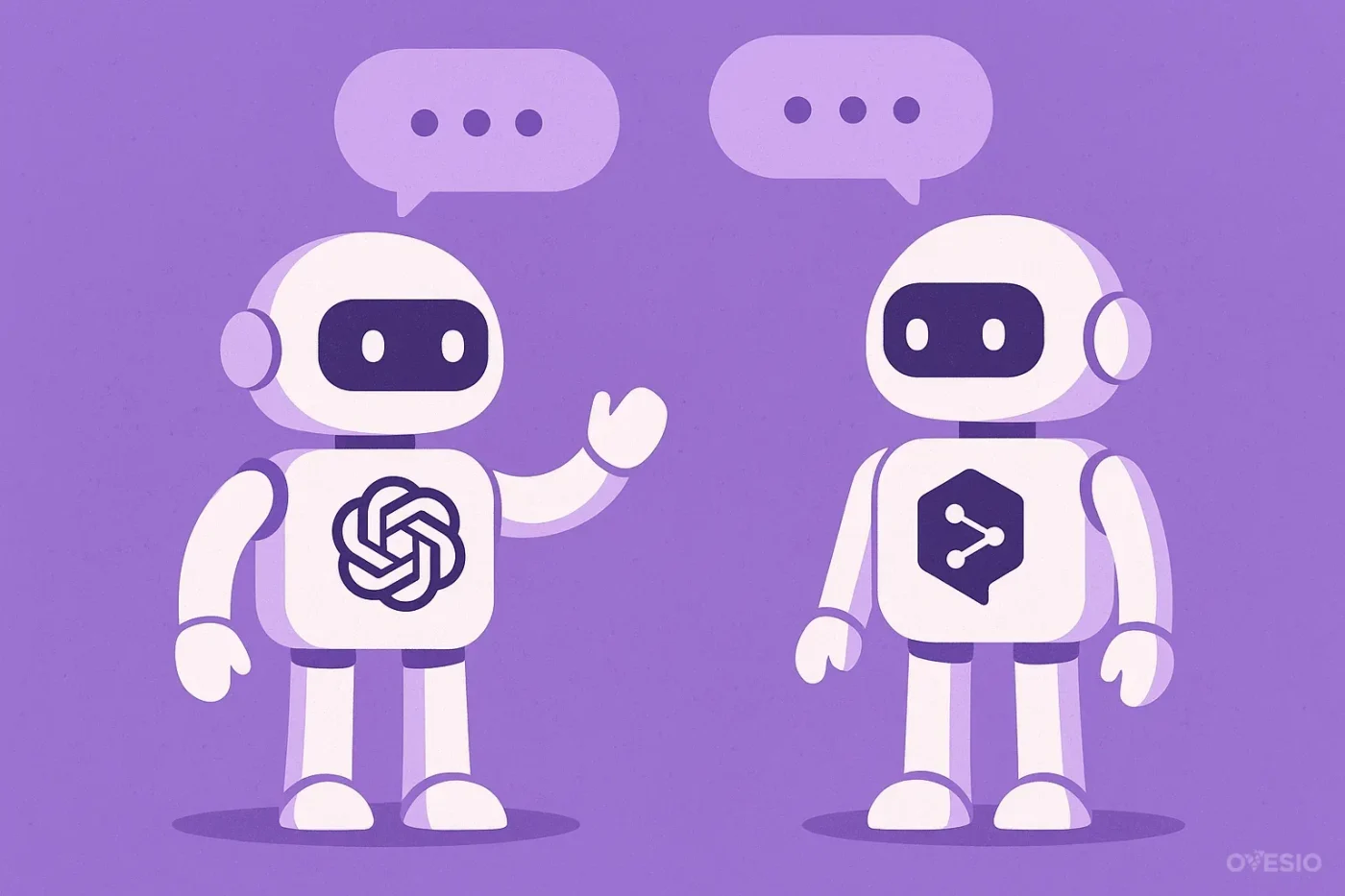
AI translation is a hot topic, and everybody is asking the same question… Is AI translation at a stage where it can be used for actual work?
Let’s answer this exact question by comparing two popular AI translation software, DeepL and ChatGPT from OpenAI!
I. Introduction: What is AI Translation
In a world that’s moving faster than ever, language can no longer be a barrier.
There’s something called AI-powered translation tools that promise instant comprehension across borders, offering speed, convenience, and accuracy. But how accurate is AI translation?
Whether you’re translating legal contracts, marketing campaigns, or just trying to decode a foreign meme, machine translation is no longer a novelty, it’s a necessity.
But not all AI translators are created equal.
Two giants dominate the landscape: DeepL and ChatGPT.
Both are advanced, both are AI-driven, and both can translate.
Yet, what powers them under the hood is fundamentally different, so the quality, speed, predictability and consistency of their translation will differ greatly.
Let’s break down those differences.
We’ll explore how each tool is built, how well they translate, what features they offer, when to use one over the other, and finally, whether AI translation is truly ready to replace humans in serious linguistic tasks.
I promise to avoid nerdy terms as much as possible, but sometimes they are needed.
II. Purpose & Core Technology of AI Translation Software
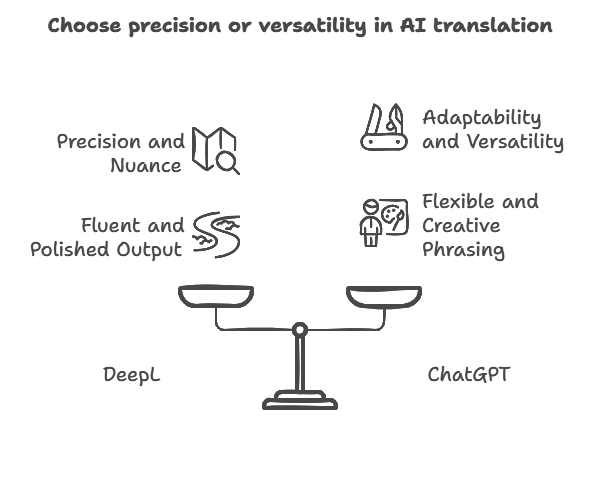
Translation software is a broad term and there are many interworking of how it works, and there are many algorithms behind them. But today we will talk about two of them, because they are the most popular today.
DeepL: Specialized Neural Machine Translation (NMT)
DeepL was born with one purpose: translation.
It’s built on a neural machine translation (NMT) framework, trained on enormous multilingual datasets.
This laser-focused design allows DeepL to excel at capturing nuance, mastering idiomatic phrases, and delivering fluent, polished output, especially in domains where precision is non-negotiable, like legal, medical, or technical documents.
It doesn’t just decode words, it leave the impression of understanding context, tone, and regional subtleties. Whether it’s German engineering manuals or French press releases, DeepL has earned a reputation for outputs that sound like they were written by native speakers.
ChatGPT: Versatile Large Language Model (LLM)
In contrast, ChatGPT wasn’t designed as a translator, it just happens to be great at it.
As a Large Language Model (LLM) developed by OpenAI, ChatGPT is a Swiss army knife of language tasks: it chats, it writes essays, it codes, and yes, it translates.
Rather than focusing solely on linguistic fidelity, ChatGPT shines in adaptability.
It can interpret tone, adjust writing style, and offer multiple phrasings or explanations.
Its strength is not in being the most “correct” translator, but in being the most flexible one.
When the task demands a mix of translation, summarization, and content adaptation, ChatGPT can switch gears effortlessly.
In short: DeepL is a hammer. ChatGPT is a multi-tool.
III. AI Translation Accuracy and Style
DeepL Translations
When it comes to raw translation precision, DeepL is the industry standard, and for good reason.
It’s engineered for formal, technical, and business-grade translation, where stakes are high and ambiguity is not an option.
DeepL’s strength lies in its ability to nail complex sentence structures and maintain natural flow across even the most dense or jargon-heavy texts.
Whether you’re working on a pharmaceutical patent or a financial disclosure, DeepL doesn’t just translate, it interprets with a native-like sensibility.
Its standout feature? Glossaries.
These let users define how specific terms should always be translated, ensuring terminology consistency across documents, a critical tool for professionals dealing with niche vocabularies or brand-specific language.
ChatGPT Tranlsations
ChatGPT takes a more imaginative approach to translation.
While it may not match DeepL’s accuracy for specialized documents, it excels in contexts where tone, creativity, or flexibility are key.
Want your translation formal, friendly, poetic, or punchy?
Just ask.
ChatGPT responds to prompts that guide its style, making it a great fit for marketing, social media, and conversational content.
Need the translation explained, paraphrased, or localized with cultural nuance?
ChatGPT can do that, too.
But here’s the tradeoff: it’s not as dependable with technical terminology.
Without a glossary function, and with occasional drift in meaning, it may require prompt tweaking and extra passes to get the result just right.
IV. User Experience & Features
DeepL UX & Features
DeepL is all about streamlined efficiency.
Translations begin the moment you start typing, with results updating in real-time.
This makes it an intuitive, frictionless experience.
The only problem with DeepL is that without context, it can miss the target. It gives some weird translations sometimes, and even returns your own text as you sent it.
But when it comes to larger texts, it’s good!
One particularly user-friendly feature is its interactive phrase selection: click on a word or sentence, and DeepL offers alternate translations instantly.
Combine that with custom glossaries and translation memory, and you’ve got a tool that delivers both speed and consistency.
ChatGPT UX & Features
Using ChatGPT for translation is more of a dialogue-driven process.
You start with a prompt, and the model responds, not instantly, but conversationally.
That delay is offset by the model’s flexibility: you can refine, adjust, and iterate in real time, making it ideal for use cases that evolve mid-task.
However, there’s a caveat. ChatGPT has no built-in glossary or persistent memory in single-turn interactions.
If terminology consistency is crucial, you’ll need to manually define terms each time or guide the model with examples and clarifications.
This will reduce the context window, and it will make the AI perform poorly if the context needed (let’s say you add a document) it’s decently sized.
However, it works better than DeepL for informal texts.
V. Use Case Scenarios of AI Translators
DeepL Use Cases
DeepL thrives in the high-stakes, high-precision world of professional translation. It’s the tool of choice for:
- Legal documents: contracts, court filings, compliance paperwork, where even a slight miswording can change the meaning entirely.
- Technical manuals: think aerospace blueprints, medical device documentation, or engineering schematics, where domain-specific language and structural clarity are non-negotiable.
- Business communications: annual reports, HR policies, internal memos, any content that requires clean, idiomatic, and formal translation.
DeepL is ideal when the job demands consistency at scale, and where accuracy beats creativity every time.
If your workflow revolves around large volumes of text and little room for ambiguity, DeepL gets it done, fast, clean, and reliably.
ChatGPT Use Cases
ChatGPT, by contrast, is the language chameleon.
It’s your best friend when translation is just one part of a more creative or conversational workflow. Best use cases include:
- Multilingual content creation: writing blog posts, captions, or scripts in multiple languages with a certain style.
- Marketing copy: localizing taglines, email campaigns, or product descriptions with tone adjustments for different markets.
- Chatbot localization: adapting conversational interfaces for global users while preserving tone, nuance, and intent.
ChatGPT is particularly handy when you need translation plus something more, like an explanation, or a rephrase.
It’s not just a translator, and this is a double-edged sword because you can use it for multiple things, but it cannot do everything at top-notch quality.
VI. Does AI Translation Really Work?
Short answer? Yes, but there’s a catch!.
AI translation has come a long way.
Tools like DeepL and ChatGPT are now capable of producing surprisingly fluent, context-aware translations that often rival (or even outperform) human translators, at least in speed and surface-level coherence.
For day-to-day use, they’re more than “good enough.”
But there’s a big asterisk.
Machine translation is not infallible, especially when it comes to nuance, tone, or culturally sensitive language. Idiomatic expressions, legal precision, or creative subtleties can still trip up even the smartest models.
- If you’re translating a product description, an email, or an FAQ page, AI can handle it.
- If you’re localizing a brand voice, interpreting legal obligations, or crafting a diplomatic communiqué, AI alone might not cut it.
That’s where human oversight comes in. Editors, native speakers, or domain experts are still essential for final review, especially when the stakes are high.
The good news? We’re seeing the rise of hybrid workflows, where AI does the heavy lifting and humans bring the polish.
It’s fast, cost-effective, and increasingly accurate, a sign of where the industry is heading.
VII. Conclusion
So, DeepL or ChatGPT?
- Choose DeepL when you need precision on specific topics, domain accuracy, and clean formatting at scale, that requires a glossary of terms.
- Choose ChatGPT when you need flexibility, explanation, or multilingual content.
Ultimately, it’s not about which is better, but which is better for the job.
At Oversio, we ran some tests and have tons of data from our AI Translators & AI Inspector and DeepL outperforms ChatGPT for most translations.
AI translation is no longer sci-fi, it’s a functional, fast, and remarkably capable tool.
If you’re curios if you can use AI translations in marketing, to reach more people, here’s an article that gives you the answer: 5 Facts You Don’t Know About AI Translation in Marketing
If you’re looking for a more complete analysis of AI in translations, this paper from International Journal of Information Managementis a great resource.
FAQ: DeepL vs. ChatGPT for Translation
1. Which is more accurate for professional translation, DeepL or ChatGPT?
DeepL generally delivers higher accuracy for professional translations, especially in legal, technical, or formal business contexts. Its output is more idiomatic and consistent, making it the go-to choice for high-stakes content.
2. Can ChatGPT replace DeepL for everyday translation tasks?
It can, but with some limitations. ChatGPT handles casual, conversational, or creative translations well and can adapt tone and style. However, it may fall short in specialized or highly technical domains where DeepL excels.
3. Does either tool support glossaries or consistent terminology management?
DeepL offers built-in glossary features and translation memory, which are ideal for maintaining consistency across large documents. ChatGPT does not have native glossary tools, though you can guide it via custom prompts.
4. Is ChatGPT better for multilingual content creation?
Yes, ChatGPT shines in scenarios that require more than direct translation, such as creating content in multiple languages, rephrasing, or generating culturally adapted messaging. It’s especially useful for marketing or UX writing.
5. Should human translators still be involved in AI-assisted translation?
Absolutely. While AI translation tools are fast and powerful, human oversight is essential for catching nuance, cultural sensitivity, and domain-specific accuracy, particularly in legal, academic, or brand-critical material.


